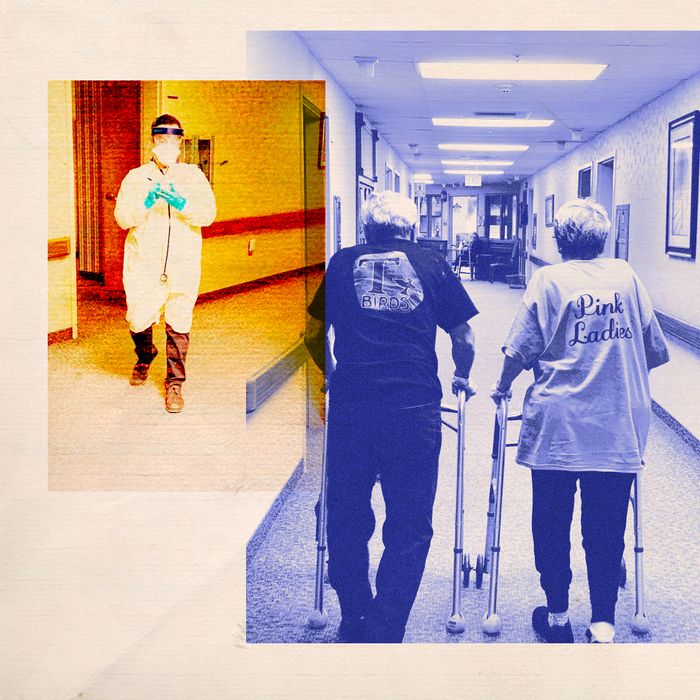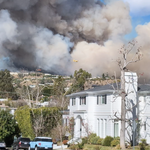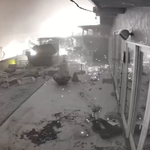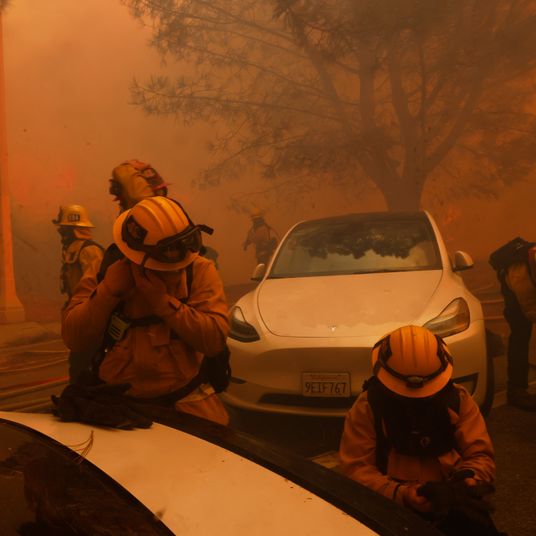
This article was featured in One Great Story, New York’s reading recommendation newsletter. Sign up here to get it nightly.
It was lunchtime on Easter Sunday, and Ben wasn’t eating his pie. Amanda Barber, a certified nursing assistant on S Wing, a unit at Fort Hudson Nursing Center that houses people with advanced dementia, knew this was odd. She has been working in S Wing since 2011, when her experience of her grandfather’s Alzheimer’s led her to request shifts there. Working in her “lounge” — one of the unit’s four collections of five or so rooms, each with a communal area — she cares for her ten or 11 residents about five days a week and is responsible for their well-being for eight or 12 hours at a time.
Beyond the more typical responsibilities — dressing, shaving, combing, feeding, toileting — S Wing staff need to intuit the needs of their often rather active residents, who may not be able to explain exactly how they feel. Barber dodges their fists, calms them, goes on walks with them in the internal courtyard among the birch trees, accompanies them on visits to other residents. She becomes a rare familiar presence in their lives, even if who they think she is can change from day to day. One woman who regularly visited S Wing said that, for her father who lived there, Barber “became his world.”
“They say not to get too close to your residents, but you can’t really help it,” Barber says. “I do every single time.” Barber loves her residents. She and her colleagues consider them family.
Having cared for him for about a year, Barber knew that while Ben was not a big lunch eater, he loved any and all desserts. And Ben, who was in his mid-80s (and whose name has been changed to respect his privacy), was normally full of energy. He would often help Barber clean up around Lounge 2, yet he hadn’t that day. Ben said nothing about feeling unwell, but at the table, with some lounge mates across from him, he had been falling asleep. Barber attempted to get him up to bring him to his room so he could lie down. But without her and another staffer’s help, Ben couldn’t walk. That was when Barber first thought S Wing had not been spared.
As COVID-19 was found in the United States in February at a nursing home in Washington, then was confirmed to have arrived in New York, then creeped into nearby health-care facilities upstate, and as nursing homes across the country became the site of more than 40 percent of the nation’s deaths from the virus, staff members at Fort Hudson hoped and prayed it would not come to their facility — and that if it did come, it wouldn’t make it inside S Wing.
Two neighboring communities — Fort Edward and Hudson Falls, New York, not far from the southeastern crumbs of the Adirondacks — had worked together to open Fort Hudson in January 1970 as an 80-bed facility that would provide a social care environment, particularly for women with dementia. The nursing center now accommodates as many as 196 residents.
Completed in 1996, S Wing can house 42 people who, though experiencing advanced dementia, have retained their physical fitness. The unit was built to foster a form of freedom. It is laid out in a squared circle so residents don’t become disoriented by the dead ends of straight hallways, as they can in other health-care environments. Rooms have more space, and the wider halls let residents walk about easily.
Some like to wander and take laps around the unit. Many do not recognize their names, so instead of nameplates on their rooms’ doors, the staff put memorabilia boxes with pictures of their families and younger selves — from a period of time they may, in that moment, believe they are living. Having unlearned many of the norms (and neuroses) that keep adults apart, residents hang on to each other, they hold hands, they hug and dance with caregivers, they take one another’s belongings, and they cough and sneeze openly, then do not think twice before touching a railing or someone else. If COVID-19 came, it would not find a better place to spread. It would transform S Wing’s freedoms into threats.
Since March, the S Wing staff had been trying to keep the residents distanced. The task was endless. Residents on other wings may follow instructions to stay in their rooms or rely on staff for help with walking, thus regulating their movements, but S Wing residents are too fit and too oblivious. “Social distancing with a demented person who does not know what that means and could go in your face and not even see you and walk right into you, that was a challenge,” says Caroljean Saunders, the unit manager. Most residents did not understand the purpose of the masks Fort Hudson provided and often refused or removed them, though at least one man in Lounge 2 who watched the news constantly took to wearing one all the time. The staff would try to coax roamers back to their rooms by, say, suggesting they go color or look at a family photo album together or by talking with them about farming. But their efforts could prevent only so much.
The day after Ben’s sudden struggle to walk, a staff member who had recently worked on S Wing told Fort Hudson leadership they had tested positive for COVID-19. Colleagues who had worked with that person had to self-quarantine. Barber started living at a friend’s house, leaving her seven fostered and adopted children, one of whom has a weakened immune system, at home with her wife.
While Ben seemed to recover from the high temperature he’d registered, within days another resident quickly became ill and also spiked a temp. Then another looked gray. Some residents’ oxygen-saturation levels dropped. That Saturday, April 18, four residents on S Wing tested positive for COVID-19.
On Monday, Dr. John Quaresima counted 21 residents on Lounges 3 and 4 who, since they showed no symptoms and did not socialize much with the other lounges, he hoped might be safe. He was concerned about the rest. By then, 11 were showing symptoms — about a quarter of the wing’s population. The remaining ten were those patients’ roommates.
The staff tried to isolate the sick while looking like aliens. The N95 masks in the full-body personal protective equipment they wore deprived residents of the main feature they use to recognize caregivers: their faces. Residents would give the staff funny looks, and even when their charges weren’t too hard of hearing and could make out the voices garbled by the N95s and face shields, caregivers couldn’t always clarify matters by saying their names; often, residents didn’t know them.
Meanwhile, strictly keeping residents in their rooms as best they could and administering meals one by one disrupted the usual flow of care, in which staff look after several residents at once. Falls that would have happened in the open — that could have been prevented — became hidden.
“People talk about appropriately isolating residents,” Fort Hudson CEO Andy Cruikshank says. “That’s where what state policy comes out with is disconnected from reality.” While in an April 10 COVID-19 prevention-and-containment checklist for long-term-care facilities, the state Department of Health acknowledged that “room restriction may need to be adapted for dementia or fall-risk residents,” it provided no specific remedy.
Quaresima had worked a few mornings a week at Fort Hudson as part of his job for Hudson Headwaters, a not-for-profit health-care network serving the region. But as he realized the danger S Wing was facing, he volunteered to lead the response with Saunders. By the 22nd, he was working there full time; the next day, three-quarters of residents either displayed symptoms or had been exposed.
The staff called a Zoom meeting for families of the Fort Hudson residents. “The tension was palpable,” Quaresima remembers. “Oh my God. It’s here. What do we do? How do we handle this?”
That Saturday morning, the 25th, test results for the remainder of the residents arrived: twenty-nine were now positive. And several who had tested negative nonetheless showed symptoms, including one who seemed near death. The only patients who now appeared to be spared were three women in private rooms.
Many residents would not remember what symptoms to look out for, and if they did, they seldom if ever articulated how they felt. They may not have realized how sick they were — or that they even were sick — let alone that an unprecedented virus now existed and was preying upon them. Family members, though banned from visiting in person since mid-March, would become vital sources of information. When one told the staff that their loved one had worryingly said the food just didn’t taste good, Saunders and Quaresima quickly realized that she must have meant she had lost her sense of smell and taste, telltale symptoms of COVID-19. A daughter alerted them that her mother had developed a dry cough — and she never had a cough. A wife let the staff know that her husband on S Wing strangely made no lusty comments about her body during a video-chat; he then tested positive.
Few if any residents displayed the classic COVID-19 respiratory symptoms. One day, Quaresima saw a male resident sitting in a chair in his room and stopped to talk with him. The man said he felt fine. Quaresima placed an oxygen meter on his finger. A desired reading is in the 90s; his was 60. It was as if he’d been sitting there holding his breath.
“I had a guy one morning who just got up, took his pants off, walked down the hallway, had diarrhea down the hallway into another room,” Quaresima recalls. “We were fighting a losing battle against the spread of the virus the second that person got infected.”
Life grew grim. “Doom and gloom was settling in like a low stratus cloud,” Quaresima says. Together, the staff agreed: They had to reverse tactics. Isolation was not viable on S Wing. The still-healthy patients with private rooms would enter lockdown. Since everybody else was assumed infected, they would be let out.
Within minutes, residents walked the halls, smiling at one another. Caregivers, now able to monitor residents in groups, scouted who was sinking in their chair or who was unusually restless. Who wasn’t acting themselves? The intimate knowledge the staff had of their residents enabled them to spot unspoken changes that others could not. It also made what was to come that much harder.
The first S Wing resident to die of COVID-19 had lived there since 2017. Before then, she’d spent decades working at local liquor stores. She was 85 and had been nearing hospice care before the outbreak began. In her obituary, like nearly all of those that would come, her family thanked the staff of S Wing.
Among the shifting government directives the Fort Hudson staff followed, one quickly felt particularly stark: Anyone who died with a COVID-19 diagnosis should be put into a body bag. Two days after the first woman passed, when an 88-year-old great-grandmother of 18 who had been in hospice care on S Wing also died, it had all become too much. The staff couldn’t zip the bag.
A certified nursing assistant found Quaresima. “Do we have to close it?” she asked him. “None of us can do it.” He went to the resident’s room, where four staff members stood by her bed. They took a moment to remember her. For a minute, they prayed. Quaresima expected the nursing staff would exit as he sealed the bag. But while they stepped to the other side of a curtain, they stayed. He would write in an email to administrators that night, “While no one was able to watch me, no one was willing to leave.”
Amelia Fuller was born and raised in Italy; she was the kind of woman who had planned for decades what her outfit would be for her open-casket wake: a shiny black-and-gray shirt she would not, in the end, be able to wear. Her family looked on, via a laptop perched on a tray table, as she faded, a bruise having bloomed around her right eye after a stroke ended a recent early-morning walk in a fall. Fuller’s daughter, Mary Lamb, who lived nearby, had been offered a compassionate-care visit. But before Fort Hudson shut down to visitors — Fuller’s boyfriend (the pair “had been like teenagers”) was one of the last to leave — Lamb had noticed that her mother sometimes thought other people were her, though Fuller still occasionally believed she had to track down a Crock-Pot to cook one of her Sunday dinners. Lamb would receive calls at night from her distraught, crying mother, who said she was stranded alongside Route 9, in need of a ride home that no one would give her. Lamb doubted Fuller would recognize her now, especially after six weeks without visits and with her shrouded by the required PPE. Lamb decided what was important was her voice.
That final virtual vigil — the third Fuller’s family had conducted — started at two in the afternoon on the 29th but lasted well into the night. The family went around the room saying what they wanted Fuller to hear. At around 5:40 a.m., her son, Carl Battiste, awoke after a brief sleep. Five minutes later, nearly 16 hours since the vigil began, Fuller passed.
A 40-minute drive away, Becky Lawler struggled to sleep. About a week prior, on her last Zoom call with her father, 95-year-old Frank Smith, who served in the Coast Guard at Normandy, Lawler had seen his condition was worsening. He struggled to catch his breath. Now, she had been told he had very little time left. Like Lamb, Lawler also declined the option of a compassionate-care visit — she worried about infecting her then-93-year-old mother, who lives with her and mostly stays in a hospital bed in the living room, and was at risk herself. Still, Lawler’s niece was able to join Smith in S Wing. She held his arm; on his pillow, she placed her phone, which played a video of his wife telling stories about their past together. At 7:40 that night — Lawler made a point to look at the clock — she received a call from her niece. Lawler looked at her mother, who said, “He’s gone, isn’t he?”
In four days, Fort Hudson had lost five residents — five members of their family, three in about 14 hours. A 99-year-old woman nearing hospice, whose bowling feats had often appeared in the local paper, had died after Fuller and before Smith. It was during that time that Saunders turned to Quaresima and said, “We cannot lose 42 of these residents of ours.”
S Wing’s normal liveliness withered. More and more residents grew ill, as those in Lounges 3 and 4 began to join those in Lounges 1 and 2 in their exhaustion. Some would rest in their beds for days, nearly unresponsive. If her residents did not want to drink, Barber put cups to their lips or gave them Jell-O or ice cream. She would rouse them, make sure they took a lap around the loop, created some semblance of the routines they normally thrived on. “I felt like once they laid in that bed it was game over, and that just broke my heart,” she says. “You’ve got to be their mind. You’ve got to be their body. You’ve got to be everything.”
Saunders has been a nurse for 47 years and saw a flu in the late aughts take several people over the course of a few weeks, but she’d never witnessed anything like this. She recalls that when she arrived at work one day, earlier in the outbreak, two patients were on oxygen; by the end of the day, 17 were. People who didn’t usually fall started falling; those who used to fall fell more. Residents would rip out devices designed to hydrate them, not knowing what they were for.
Saunders noticed that some form of internal unrest led the sickest to strip off their clothing; an acquaintance whose brother had tested positive described it to her as a sort of effervescence, a bubbling in the arms and chest. To protect their privacy, she would close these residents’ curtains and gently tie a light gown around them.
Fort Hudson adapted to new instructions. Government directives would arrive on weekends or during off-hours, sometimes requiring immediate attention and action though often with unclear or incomplete information, Cruikshank says. He felt their authors lacked expertise. “New York’s governor has done a great job in many areas in handling this. I don’t diminish that,” he says. “But in many ways, I think the state government, and it starts in the governor’s office, views nursing homes as nothing more than a line item in the Medicaid budget. And they do not accept the extraordinary risks that nursing homes present with this particular virus. They underestimated it, and when they found they underestimated it, they quickly shifted gears to casting blame, as opposed to saying, ‘What can we do to help out?’”
On May 2, S Wing lost its sixth resident, an 86-year-old man who had been an antique-car enthusiast and achieved his dream of owning a bar. Starting on May 4, the unit lost one resident in each of three consecutive days: first, an 83-year-old man who had received the National Defense Service Medal and Good Conduct Medal for his service in the Air Force; then an 89-year-old woman, another avid bowler; then a 91-year-old woman who had loved to dance and had jokingly called Saturdays “tight-shoe night.”
Caregivers came back off-hours to sit beside patients who were nearing the end. In one instance, after working all day with a declining resident, two staffers decided they would both go home, take a shower, get some new clothes and some fresh coffee, then return and suit up in the sweltering PPE to be with a longtime resident in her final moments. They sat practically in bed with her, stroking her hair, as her family joined on Zoom, together laughing and crying.
The caregivers had experienced the deaths of residents many times before. It was part of the job. But not at this rate. And not without being able to hold the residents’ grieving relatives. These family members had often first cared for their loved one in their homes as his or her dementia grew, before finally trusting and turning to Fort Hudson. Many often visited S Wing, offering companionship to the caregivers, even into the night, for years. The staff considered them family, too. “It’s just so difficult when it’s on Zoom, and somebody is leaving the room and they’re crying and you just want to hug them and you can’t,” Saunders says. The staff ached for the day when they could.
Tanya Mattison, the unit’s medical secretary, who used her experience as a nursing assistant to help in whatever way anyone needed, was responsible for packing up late residents’ belongings for their families. She took to drawing hearts on the boxes, hoping to send the message, Hey, I remember your family member. We love you.
Five years before, Mattison had lost both her parents in four days, and she used the lessons she learned then to try to help her coworkers. She sought to speak with everyone every morning to see how they were. Human resources found a social worker they could talk to, and Saunders ensured everyone knew the phone number so they didn’t ignore the call.
Many staff members lost weight. “We were definitely too afraid to eat,” Barber said, even as residents’ families or the community so generously sent food — sandwiches, Olive Garden, and other snacks and treats. They vented in regular meetings. Barber would step outside the unit to cry. Saunders recalls a time when she had begun breaking down in her office and a colleague came in and said, “Oh, Carol,” and teared up as well. They would have hugged, but they knew they couldn’t.
Weeks into the outbreak, some S Wing residents began getting better. On Mother’s Day, as an 85-year-old woman who had loved playing Nintendo and drinking orange soda with her grandchildren became the tenth S Wing resident to die of COVID-19, ten other residents had reached the New York State standard of recovery.
These improvements could be misleading, however. COVID-19 aside, while some dementia patients may lose their cognition earlier on in their final stages than other elderly patients, they can also experience sudden moments of lucidity right before the end, Quaresima says.
Michelle Cerro seemed to be among those getting better. Staff told her daughter, Dr. Cindy Cerro-Conlon, they were “cautiously optimistic” she would recover. And now that Cerro was chatty, singing, and active, Cerro-Conlon told her father what seemed like good news. Cerro’s husband had visited her every day when she was in S Wing to feed her lunch; he would bring a bag of Lindt truffles — the one with milk, dark, and white chocolates — for her and her fellow residents. The couple had owned and run a diner together on Route 4 in Hudson Falls, which gained a reputation for Michelle’s pizza and lasagna. June would bring their 58th wedding anniversary.
The next day, Cerro was unresponsive. As an anesthesiologist, Cerro-Conlon had her own PPE, so she went in to be with her mother as her family joined on Zoom for what would be Cerro’s final 20 hours. “Staff were turning her, and while one aide rubbed her back, the other massaged her legs with lotion,” Cerro-Conlon recalls. She held her mother’s hand in her own gloved hand. She badly wanted to feel her mother’s hand on her cheek, but she couldn’t. She tried to soothe her mother however she could, running her fingers through her hair. Around 11:30 in the morning on May 12, two weeks shy of her 79th birthday, Cerro died. She was the last resident of S Wing to succumb to the coronavirus.
Cerro-Conlon and her family had decided when Cerro arrived at Fort Hudson that they would not send her to a hospital for any illness that seemed irreversible, and while they were reminded that they could change their mind, they did not waver after her COVID-19 diagnosis. Fort Hudson says each late S Wing resident’s family made the same decision, having previously signed “do not resuscitate” or “do not intubate” or “do not hospitalize” orders; the Fort Hudson staff told them the statistics, which showed that a violent, last-hope procedure like intubation, which a hospital might offer, provided little promise to patients in their condition. Each of the eleven S Wing residents who died during the outbreak had someone present in their final moments, either by their bedside or over Zoom. Each one passed in what had become a home, among people who had signed up to care for them not for hours or days or weeks but for however long the long term would last.
After losing her first resident, Saunders did not sleep well. Before work, she went to her window, where she kept an electric candle. She brought it to the S Wing lobby and plugged it in there — an act she repeated after each death. Nameplates, a prayer, a painting of a heart in a rainbow, and countless handwritten thank-you notes from families now surrounded the 11 candles. She told the staff, “They will be there until we’re ready for them to go.”
As the residents of S Wing regained their strength and energy, their personalities returned. While the halls of other wings remained largely empty, S Wing’s became lively again. Residents started going outside with staff as springtime sun and warmth arrived. Music played. They partied. When asked if they wanted a drink of water, one quipped that they’d take a Tom Collins. Some residents seemed shaken that their neighbors were no longer around; others didn’t understand.
By the time the remaining residents met the standard for recovery, in late May, about 5,750 residents of New York nursing homes or adult-living facilities had died of COVID-19. A debate over whether a New York State directive to send about 4,500 patients infected with the virus to nursing homes, rather than keep them as far from those vulnerable populations as possible, was roiling. At Fort Hudson, questions lingered: How had two residents managed to test negative once, twice, three times, four times, five times? Even when one had licked the handle of a blocked-off water fountain? Should they be released from isolation? And what would happen if COVID-19 came to another wing? Would it be worse?
“There’s so many losses in this, but there have been so many blessings,” Saunders says — the letters of support, the abundance of PPE throughout, the staff and the closeness they gained. Nostalgia and sadness sat together. Hearing Frank Sinatra’s “My Way” sent Quaresima’s mind back to the scene of a resident experiencing a cytokine storm, in which the immune system attacks the body, leading the man to struggle for breath more than Quaresima had ever seen, while caregivers stroked his hair, held his arm, and played music to try to calm him, which they eventually did.
Mattison missed the residents’ wandering, how some would play with the files on her desk, how a man would give a knowing, mischievous smirk. “It’s that smile you miss,” she said. “It’s those little things.” On June 8, the residents dressed up in Grease-themed tee-shirts — the women as Pink Ladies and the men as T-Birds — that read “I’m COVID free!” on the front. Saunders was so happy to see the residents out and about, but she couldn’t speak of some deceased residents without tearing up. During the worst stretch, Fort Hudson instituted daily calls to each S Wing resident’s families to provide an update on their vitals and prognosis; now Saunders still tries to call the late residents’ families every two or three weeks.
Fort Hudson allows visits again, under strict guidelines. They must be scheduled and then take place outdoors, observed by staff. The caregivers adjust people’s masks. And they still make sure no one hugs.
During the outbreak, Barber’s children didn’t understand why she hadn’t been home week after week. She would tell them, “I have really sick people at work, and I’ll be home when they’re better.” Though too soon after her residents recovered, Barber received frustrating news: She had tested positive for COVID-19. She could not work. She could not yet go home. For weeks, she could not be with her families.
When Barber returned to S Wing, her residents were excited to see her. Some wondered where she had been and had worried she wasn’t coming back. A couple were especially grateful, telling her only she really knew what they liked to eat.































